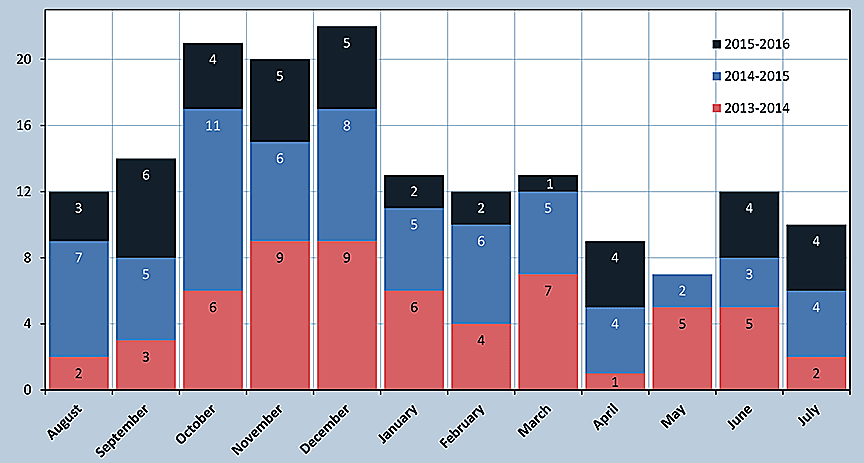Faye Ackermans
Member, Transportation Safety Board of Canada
1 November 2016
Ottawa, Ontario
[Slide 1: Title page]
[Slide 2] Watchlist 2016
- Transportation of flammable liquids by rail
- Following railway signal indications
- On-board voice and video recorders
- NEW - Fatigue management systems for train crews
- Safety management and oversight
- NEW - Slow progress addressing TSB recommendations
[Slide 3] Issue removed: Railway crossing safety
- TC published new Grade-Crossings Regulations and Standards (2014)
- Crossing accidents are now declining
| 2011-2015 (avg.) | 129 |
|---|---|
| 2015 | 117 |
| 2016 | 89 |
[Slide 4] Collisions with vehicles by crossing type
| Aug 2013 – July 2014 | Aug 2014 – July 2015 | Aug 2015 – July 2016 | |
|---|---|---|---|
| Farm/Private | 17 | 39 | 26 |
| Public-Passive | 59 | 66 | 40 |
| Public-Automated | 79 | 76 | 66 |
| TOTAL | 155 | 181 | 133 |
[Slide 5] Collisions with vehicles on public passive crossings
[Slide 6] Action required:
- Need ongoing commitment by all
- Continued funding to sustain improvements, particularly at public/automated crossings
- Driver education remains key
- TSB will continue to investigate and learn from accidents at crossings
- TSB will continue to support Operation Lifesaver
[Slide 7 & 8] On-board locomotive voice and video recorders
Without these, key information to advance railway safety may not always be available for accident investigations and proactive safety management.
Recent actions:
- May 2015: TSB safety study released September 2016
- The report identified best practices, implementation issues, and collected background info to support action plan
[Slide 9] Issues:
- Differences in opinion on appropriate use. Need to resolve these disagreements.
- Rights and obligations of all parties must be balanced to use this information in a proactive safety management framework.
- The TSB will continue its work to prepare for expanded use.
- Legislative changes required.
Action required:
- Recorders must be installed on all lead locomotives operating on main track.
[Slide 10 & 11] Following signal indications
Railways signals are not consistently recognized and followed, which poses the risk of serious collisions or derailments.
Any progress?
- VIA is in the early stages of testing new technology.
Action required:
- Additional physical safety defences must by implemented to ensure signals are consistently recognized and followed.
[Slide 12 & 13] Transportation of flammable liquids
The transportation of flammable liquids, such as crude oil, by rail across North America, has created an elevated risk that needs to be mitigated effectively.
Progress so far:
- New tank car standards
- Retrofit provisions, implementation timelines, monitoring & enforcement
- Significant decline in use of “legacy” Class 111 tank cars
Action required:
- Companies must conduct thorough route-planning and analysis, perform risk assessments, and ensure effective risk-control measures
- Use more robust tank cars when large amounts of flammable liquids are transported by rail
[Slide 14] New issue: Sleep-related fatigue in operating crew can impair the safe operation of freight trains
Why this matters:
- Since 1994, 20% of TSB investigations involving human factors showed fatigue as a contributing or risk factor.
- Almost all of these (19 of 23) involved operating crews on freight trains
- A recognized problem for over 20 years
- Initiatives to date are inadequate
Action required:
- TC to complete review of fatigue-management systems
- TC and railways to implement effective mitigation strategies
[Slide 15] Multi-modal issue: SMS and oversight
- Some transportation companies do not manage safety risks effectively
- Many [air and marine operators] aren’t required to have formal safety management processes in place.
- TC oversight and intervention aren’t always effective at changing companies’ operating practices.
Action required:
- If you have an SMS, you must demonstrate that it works
- When TC intervenes, it must change unsafe operating practices
[Slide 16] New issue: Transport Canada action to address TSB recommendations is too slow
Why this matters:
| Mode | 10–14 years | 15–19 years | More than 20 years | Total |
|---|---|---|---|---|
| Air | 3 | 4 | 32 | 39 |
| Rail | 1 | 1 | 1 | 3 |
| Marine | 3 | 1 | 6 | 10 |
| Total | 7 | 6 | 39 | 52 |
Action required:
- TC: a clear commitment to action
- Government: accelerate the process to take action
- Backlog of outstanding recommendations must decrease
[Slide 17] Next steps:
- The TSB is being more proactive. Your phone may ring.
- We want to see concrete action. You don’t have to wait for TC.
- Crossing safety: Ongoing commitment and funding required.
- Robust tank cars: We need more, and sooner.
- Following signal indications: We need more physical fail-safe defences.
- LVVR: The sooner, the better.
- Fatigue: Apply the science and take mitigation measures.
- SMS: Does yours work? Can you prove it?
[Slide 18] Questions?
[Slide 19] Canada watermark
20161101.pdf733.32 KB
